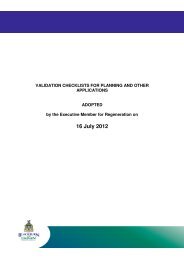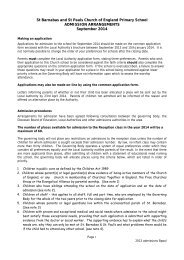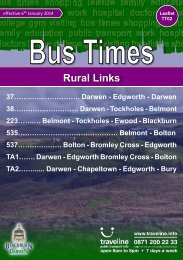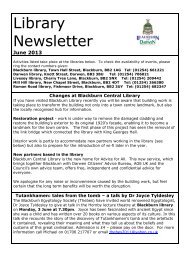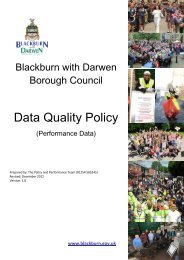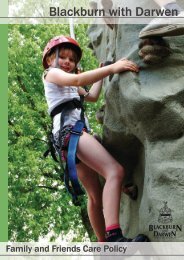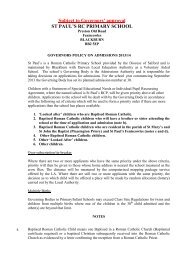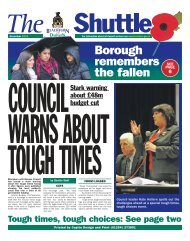Cycling strategy - Blackburn with Darwen Borough Council
Cycling strategy - Blackburn with Darwen Borough Council
Cycling strategy - Blackburn with Darwen Borough Council
Create successful ePaper yourself
Turn your PDF publications into a flip-book with our unique Google optimized e-Paper software.
<strong>Blackburn</strong> <strong>with</strong> <strong>Darwen</strong> <strong>Cycling</strong> Strategy<br />
Cycle training and engagement<br />
With the third highest percentage of children under<br />
the age of 16 years in the whole of England (25.2%)<br />
the borough has a very young population and<br />
consequently a lower than average proportion of the<br />
elderly. Furthermore, <strong>with</strong> over 20% of the population<br />
being of Asian heritage (UK average 4.4%) the cycle<br />
<strong>strategy</strong> needs to reflect the boroughs very distinct<br />
demographic profile.<br />
Over the next 20 - 30 years the Government proposes to<br />
dramatically increase the levels of cycling and walking to<br />
reduce issues of childhood obesity and reduce the reliance<br />
placed upon the private car. The aim is to make walking and<br />
cycling modes more convenient, attractive and a realistic<br />
choice for many more short journeys, especially those to<br />
work or school.<br />
Being active is especially important to children and so a<br />
great deal of emphasis from Central Government has been<br />
placed on developing a child’s skills in order for them to walk<br />
and cycle in safety and confi dence.<br />
Children and young peoples plan<br />
The Children Act 2004 set out the vision for the<br />
future of children and young people. It envisaged the<br />
integration and co-ordination of all services delivered<br />
for children, young people and their families.<br />
The ‘children and young peoples plan’ sets out the top<br />
priorities for improvement, as set by the children and young<br />
people’s strategic partnership (C&YPSP). Over the next few<br />
years the individual organisations that make up the C&YPSP<br />
will focus on 25 top priority areas and combine their efforts<br />
to achieve the specifi c targets set for each priority.<br />
Of great signifi cance to the cycling <strong>strategy</strong> is the priority<br />
to encourage children and young people to adopt healthy<br />
lifestyles. Two actions that have been outlined to help<br />
achieve this priority are:<br />
➔ Increase the proportion of children and young<br />
people achieving at least two hours per week<br />
physical activity to 85% by March 2008<br />
➔ Ensure that 50% of schools achieve national<br />
healthy school status <strong>with</strong> effective healthy eating<br />
and physical activity policies and practice by 2007.<br />
Actively promoting cycling to school and for leisure journeys<br />
is one way in which this priority area can be achieved.<br />
However it is vital that the infrastructure is in place to help<br />
develop the necessary skills required for children to become<br />
safe and confi dent cyclists.<br />
School cycle training<br />
<strong>Blackburn</strong> <strong>with</strong> <strong>Darwen</strong> <strong>Borough</strong> <strong>Council</strong>’s cycle<br />
proficiency training currently takes place in the last few<br />
months of the summer term working <strong>with</strong>in schools <strong>with</strong><br />
children over the age of 10 years, usually years five<br />
and six.<br />
The Capita road safety team, on behalf of the <strong>Council</strong>, coordinates<br />
and delivers cycle training <strong>with</strong>in the borough and<br />
this is offered to local schools on a fi rst come fi rst served<br />
basis as there currently isn’t the level of resources available<br />
to service all schools.<br />
The training takes place over three sessions. Session one<br />
involves looking at cycle maintenance, general ability to ride<br />
a bike <strong>with</strong>in a safe environment (playground), signalling,<br />
control of the bicycle and stopping safely.<br />
Sessions 2 and 3 takes place over two consecutive half<br />
days either am or pm sessions. In these sessions the team<br />
look at the four main manoeuvres turning left and right out<br />
of a minor road to a major road and turning left and right<br />
from a major road to a minor road. Overtaking, positioning,<br />
observation and safety in moving traffi c is also included.<br />
These two sessions are generally undertaken on a local, risk<br />
assessed, T-junction close to the school, unless the school<br />
prefers playground sessions.<br />
Through continual assessment from the road safety unit,<br />
every child is assessed to see if they will pass the course.<br />
The children are given certifi cates for their cycle workbook,<br />
which is also part of the course, and their training. They are<br />
also given cycling information leafl ets, cycle smart magazine<br />
(produced by the Department for Transport) and a few other<br />
goodies.<br />
They are also warned that, though they have completed this<br />
cycling course, they must continue to practice the skills they<br />
have developed so as to become more confi dent cyclists in<br />
the future.<br />
Given the extremely young population of the borough<br />
increasing the numbers of young people cycling is clearly<br />
a key priority for the <strong>Council</strong>, therefore ensuring adequate<br />
training and promotional facilities are available to schools is<br />
of paramount importance.<br />
30




